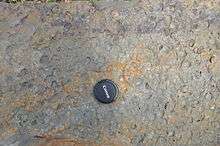Lock Haven Formation
The Lock Haven Formation is a Devonian mapped bedrock unit in Pennsylvania, in the Appalachian Mountains of the United States.
| Lock Haven Formation Stratigraphic range: Devonian | |
|---|---|
| Type | sedimentary |
| Unit of | Susquehanna Group |
| Sub-units | lower shaly member, upper sandy member, Minnehaha Springs Member |
| Underlies | Catskill Formation |
| Overlies | Brallier Formation |
| Lithology | |
| Primary | siltstone, shale, sandstone |
| Other | conglomerate |
| Location | |
| Region | Appalachian Mountains |
| Country | United States |
| Extent | Pennsylvania |
| Type section | |
| Named for | Lock Haven, Pennsylvania |
| Named by | Faill and Wells, 1977[1] |

Description
The Lock Haven is gray to green-brown sandstone, siltstone, and shale and is over 400 million years old. It is located in northcentral Pennsylvania.[2][3]
Stratigraphy
The Lock Haven may underlie various members of the Catskill Formation, although it may be a lateral equivalent of the Sherman Creek or Irish Valley Members of the Catskill. It is also a lateral equivalent of the Foreknobs Formation and underlying Scherr Formation. The Brallier Formation usually underlies the Lock Haven.[4]
The Minnehaha Springs Member (originally proposed as a member of the Scherr Formation) is a "clastic bundle" consisting of interbedded medium gray siltstone and olive gray shale with some grayish-red siltstone and shale and some sandstone. It is interpreted as turbidites.[5] This member is proposed to define the base of the Lock Haven Formation.[6]
Notable Exposures
- Pine Creek Gorge[7]
- Leberfinger Quarry, near Forksville in Sullivan County, Pennsylvania. Brachiopods, Cruziana and other trace fossils, and carbonized plant fossils are present.[8]
References
- Faill, R.T., and Wells, R.B., 1977, Bedrock geology and mineral resources of the Salladasburg and Cogan Station quadrangles, Lycoming County, Pennsylvania, IN Faill, R.T., Wells, R.B., and Sevon, W.D., Geology and mineral resources of the Salladasburg and Cogan Station quadrangles, Lycoming County, Pennsylvania: Pennsylvania Geological Survey Topographic and Geologic Atlas, 4th series, 133cd, p. 32-44, scale 1:24,000
- Owlett, Steven E. (1993). "Of Brachiopods and Glaciers". Seasons Along The Tiadaghton: An Environmental History of the Pine Creek Gorge (1st ed.). Petaluma, California: Interprint. pp. 27–38. ISBN 0-9635905-0-2.
- "Map 67: Tabloid Edition Explanation" (PDF). Pennsylvania Department of Conservation and Natural Resources, Bureau of Topographic and Geologic Survey.
- Stratigraphic correlation chart of Pennsylvania, T. M. Berg, M. K. McInerney, J. H. Way, and D. B. MacLachlan. 1983; 3rd printing, revised, 1993. 1 sheet, 42" x 58", plus 2 p. addendum.
- Lyke, W.L., 1986, The stratigraphy, paleogeography, depositional environment, faunal communities, and general petrology of the Minnehaha Springs Member of the Scherr Formation: Southeastern Geology, v. 26, no. 3, p. 173-192.
- Warne, A.G., and McGhee, G.R., Jr., 1991, Stratigraphic subdivisions of the Upper Devonian Scherr, Foreknobs, and Lock Haven Formations near the Allegheny Front of central Pennsylvania: Northeastern Geology, v. 13, no. 2, p. 96-109.
- Berg, T. M. (1981). "Atlas of Preliminary Geologic Quadrangle Maps of Pennsylvania: Tiadaghton" (PDF). Pennsylvania Department of Conservation and Natural Resources, Bureau of Topographic and Geologic Survey. Retrieved 2008-08-05.
- The Haystacks, "Ricketts Folly," and The End of the World: Geology of the Glaciated Allegheny High Plateau, Sullivan, Luzerne, and Columbia Counties, Pennsylvania, 71st Annual Field Conference of Pennsylvania Geologists (field trip guide book), J. D. Inners, G. M. Fleeger, eds., 2006